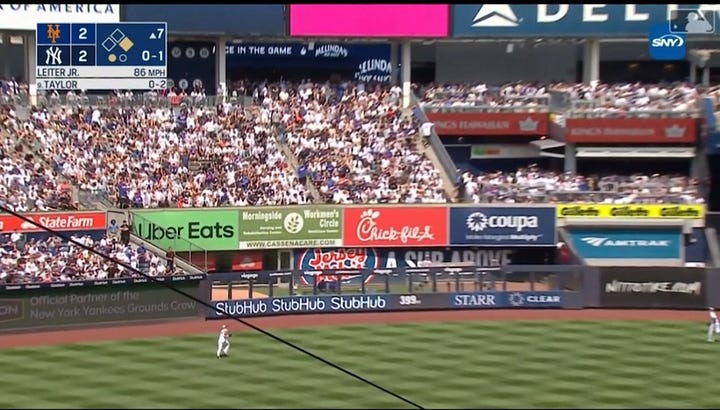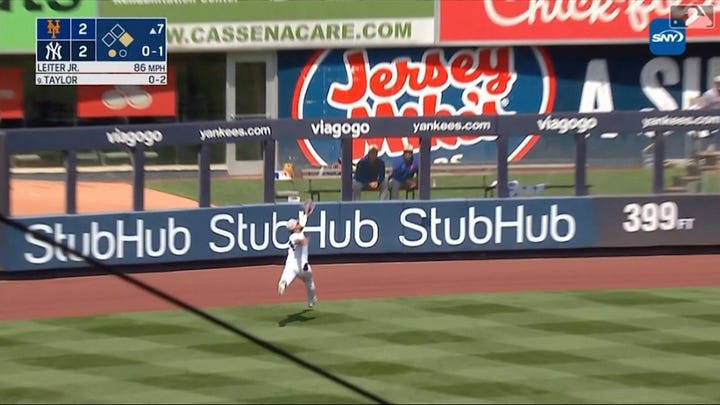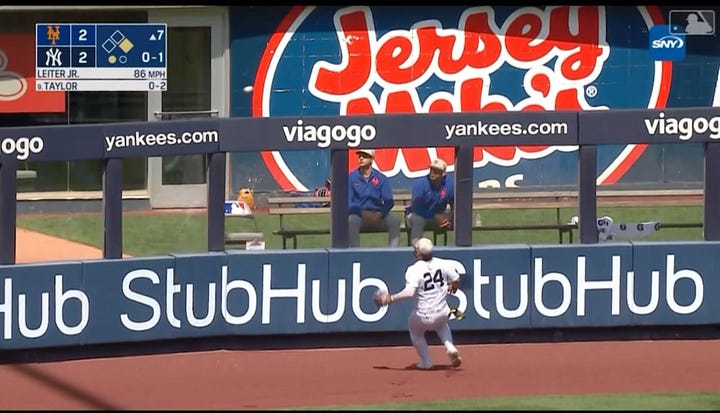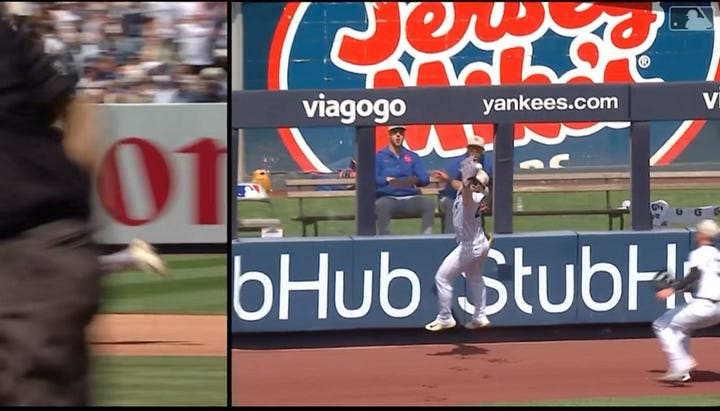Rewarding The Hustle
The game was tied at two when Tyrone Taylor drove a ball off Mark Leiter Jr. deep into left-center at Yankee Stadium. Brett Baty, who had reached base via fielder’s choice, jogged towards second while reading the flight of the ball. After a few strides, he committed to a full sprint. An average runner underway, Baty was headed towards third base by the time the ball was secured by a Yankees outfielder.
The Mets acquired Taylor from the Brewers prior to the 2024 season in a larger trade that improved their defensive versatility and speed in the outfield. Milwaukee, in turn, gained financial relief.
At his best, Taylor also offers right-handed power. His at-bat against Leiter showed a glimpse of what Brewers scouts envisioned when the team selected him in the second round of the 2012 Draft.
The ball landed on the warning track, barely beyond where the outfield grass ends and the dirt and brick dust begins. With Mets third base coach Mike Sarbaugh waving Baty around, the focus of the play shifted.
Here is that play:
Yankees left fielder Jasson Dominguez took off in pursuit of the ball. He didn’t take the most direct route, an issue that’s equally symbolic of his path to the big leagues as it is revealing of the state of his defensive game.
We’ve known Dominguez since 2019, when the Yanks gave the then-16-year-old Dominican more than five million reasons to wear pinstripes. Now, with his rookie status still intact after dalliances at the highest level in each of the last two seasons, the 22-year-old is beginning to steady himself. He’ll get there with the help of his teammates.
Cody Bellinger, meanwhile, doesn’t have a Gold Glove on his mantle because he likes the view from the outfield. At the crack of the bat, the former Rookie of the Year and 2019 NL MVP took off from his post in center to pursue the ball. Whereas Baty had to read the ball’s flight before committing to an all-out sprint, Bellinger was off to the races immediately.
Running to back up Dominguez, Bellinger put himself in a position to make a play. At the simplest level, there’s really nothing more a fan, coach, or teammate could ask for.
Keep in mind there was a chance — perhaps even a good chance — that Dominguez would have corralled the ball either on the fly or off the carom. By the time Bellinger gloved the ball, he had traveled about 150 feet from where he set up in straight-away center field when the pitch was delivered. His hustle was rewarded.
Statcast data tells us that Bellinger’s average competitive throw from the outfield averages 91.5 MPH, slightly stronger than Dominguez’s 89.4 MPH. Bellinger also tops out a couple clicks higher than his teammate with a max velocity of 99 MPH. When it comes to jumps, speed bursts, and arm strength, Bellinger outperforms Dominguez as well.
The ball snagged by Bellinger could have deflected any number of directions. It ended up bouncing the right way and to the right person because the right person did everything in his power to get there.
Quite often this past tee ball season, all 10 boys on the roster showed up to play. With no catcher position at the 6U level, the roster size dictated that we create two defensive positions that didn’t exist. Usually, we stationed a player just in front of second base while spreading four outfielders across the grass.
Against the younger, lesser experienced teams, anyone who believed that baseball was boring would have had an easy argument. What better way to kill a kid’s interest in the game than to make him stand in the outfield, awaiting a batted ball that’s never coming.
During the defensive half of the inning, I like spending time with the right fielder. A position associated with the worst little leaguers, it’s actually the best outfield position at several levels. The player essentially has two choices on every play: pick daisies or hustle behind the first baseman to back up the throw. Movement is the key to maintaining interest and some semblance of focus at the youngest age group. The hustle is generally rewarded.
Movement is key to the big league game as well. This, after all, is a story about Cody Bellinger’s hustle. The play neither starts nor ends with Bellinger. It simply requires it.
Check out these four still frames from the play. Dominguez pursues, extends, overruns, then misses the ball as it bounces off the wall. If we could zoom out just a little, we’d see Bellinger entering the picture. With the ball still unsecured, the fourth frame shows that this replay has been produced with a split-screen to show Baty’s progress on the basepath.




Without total commitment, Bellinger would have never set into motion an unlikely relay that begat a terrific play at the plate. And because the final score of the game favored the Mets, the potentially game-saving heroics disappeared.
That’s why I’m here today. Bellinger’s effort, awareness, and skill can’t be diminished by the scoreboard. Is the play irrelevant because the Yankees ultimately lost the game? No way. Two-time NBA MVP Giannis Antetokounmpo might call it “steps to success.”
The hustle and athleticism advances an organization’s winning culture. I don’t think Dominguez will forget about the teammate who has his back.
The funny part to me is that the MLB-curated highlight doesn’t focus on Bellinger’s effort. The outfielder also made a perfect throw to Anthony Volpe, whose relay to the plate was good enough to get Baty. The tag was reviewed, and so the broadcast and replay focused on the runner’s foot and the catcher’s tag. As for Bellinger, well, how about a little something, you know, for the effort?
The hustle must be rewarded.


